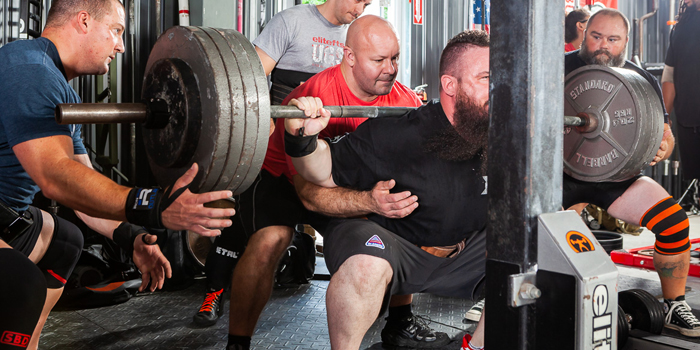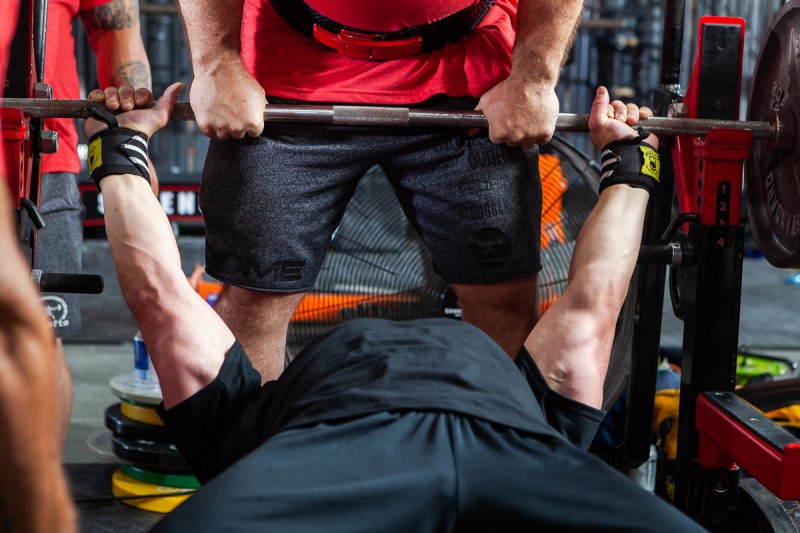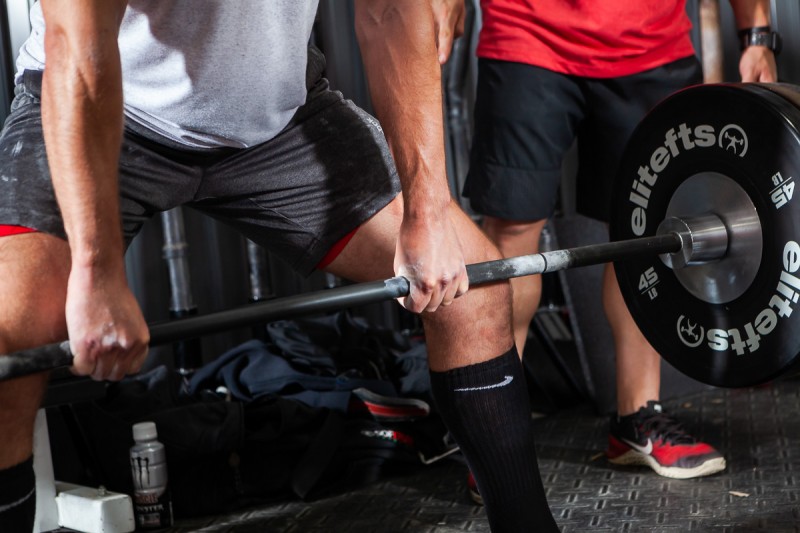
Have you ever heard the bullshit that it doesn’t matter how fast or slow you lift the barbell if you squeeze the muscles and do your reps? It’s always the number of reps and the volume that counts. That could be kind of true for beginners, as their reps are mostly about finding the right path for the nervous system to fire the signals to the muscles. For us more educated lifters, it couldn’t be more wrong!
We are talking about lifting the bar at a certain speed. A certain speed is a speed in a certain direction. Speed is calculated with meters per second. An object in motion keeps its speed in the same direction if no other force affects it. Therefore, we should put more focus on the acceleration in our lift because we want to add more force to the bar. At least, if we want to get maximum strength development. You can divide strength into different moments, which we discuss a little later. But in any case, acceleration is one of the most important components for building maximum strength. However, you should not confuse acceleration with explosiveness.
RECENT: You're Training Your Pecs Wrong
Explosiveness is about lifting at a high speed, whereas acceleration is about increasing the speed. To train for explosive strength, we usually use 30-70% of 1RM, whereas training acceleration for more raw strength development is closer to 70-100% of 1RM. Understand that you should not count out the effect of explosiveness, as it contributes to acceleration strength through a synergistic effect. This goes hand in hand with the system of Westside Barbell with Max Effort and Dynamic Effort. You must understand what kind of effort you must put in the work to get the effect of it!
The heavier an object is, the more power is needed to get it moving. Acceleration increases the force, and the more the object moves, the more force can be added in form of acceleration. If the bar is lying on the ground, it is called a stationary load. The stationary load can never change its weight (without increasing the mass) until it passes into a dynamic movement. A mass of motion has energy called kinetic energy; this amount of kinetic energy is always the same—until it is influenced by some external force (e.g., gravity or muscle work). A mass, whether stationary or moving, is always in the same state if no external force affects it. That’s why we must place much focus on creating the force, to get the power as an outcome.
When a stationary mass is influenced to move, the acceleration of the mass is always in proportion to the forces that affect it. It’s even possible to calculate the acceleration by dividing the force (F) by the mass (m), F / m = acceleration.
Because every move always has an equally opposed reaction, we can also use it to develop even more strength. If we pull a deadlift, the bar goes up from the ground while our feet are pressed downward to the floor. Try to press your feet harder against the floor without losing your posture—you get more power to do the lift. When you do a bench press, you automatically tighten your back against the bench and your feet against the floor. If you squeeze your back harder against the bench, you get more power into your lift! If you press your feet harder against the floor, you get a more tensed arch allowing your upper back to squeeze even harder and add power to the lift.
Even though you can use this reactive strength function, you must pay attention to the technique. It is important to be technical in the lifts, as we strive for the shortest lifting way possible. A short lifting distance makes the path decrease, and the shorter lift becomes less energy-craving, which gives more power to the lift.
Within physics, the concepts of work, energy, and power measure the effort required to get a movement done. It explains how energy is transferred between objects or systems and the amount of time it takes. As we train to grow stronger, we constantly strive to be more effective in administering our work, energy, and power. If you take Boris Sheiko’s training concept, for example, he recommends that you must never do many reps in a percent over 80% of 1RM. Studies have shown that you can store power and energy to do work for five reps at 70% of 1RM and still have a good technique in the lifts. With 80%, you can do 3-4 reps in a straight lift position, but the technique in the repetitions after that will suffer. The answer is to do fewer reps and more sets instead. For example, you can do five sets of four reps and have a total of 20 reps as a quality volume. If you should have done two sets with 10reps instead, you might have a volume of 20 reps but only 10 reps in quality volume.
Did you know that energy can’t be created and can’t disappear? It can only change shape. Movement energy or kinetic energy depends on the object's motion, whereas potential energy depends on the position/location of the mass. The location of the item creates stationary energy by the gravity that pulls all mass down with 9.82m/s each kilogram. That means if you pull a weight from the floor with 0.8m/s—as you do in strength speed—it adds power to the gravity with 10.62m/s instead (each kilogram). Say you have a barbell with 200kg on, the stationary load is 200kg, and when you add 0.8m/s to it, it matches 216kg just from the added kinetic energy! Here, you have a free ride to build strength just by speeding up your lift!
In speed strength, we place more focus on speed than strength. So, here you must pull the bar in 1.0-1.3m/s instead of 0.8-1.0m/s as we do in strength speed. To pull at that speed, you can’t go too high in your 1RM percent. If you could pull 200kg at 1.3m/s, it would represent 11.12m/s and would match 226.5kg. That’s amazing, as the only thing you add is speed! So, in a way, you could gain strength by adding speed instead of directly increasing the load. If you just can pull 200kg at 0,8m/s, it’s impossible to increase the speed more. But over time, you can speed up your lift, and that will make you stronger!
- Strength speed (70-100%) – Relatively high load as fast as you can, but the focus is on the load.
- Speed strength (30-70%) – Move the bar at a very high speed with the maximum weight you can handle at a certain speed. If the speed is too slow, you’re no longer training in the area of speed strength.
If you want to move a heavy load with a small force, you can use a lever. But in the same way, a load that is held outside of the body will create a larger load with a smaller weight. Therefore, it is important to minimize the lever arms and to place the weight as close to the body as possible to handle a larger load. In that way, we can maximize our performance because we can handle a greater load. If you are unsure what I mean, try lateral shoulder raises with bent arms and then with straight arms.
Keep in mind that moment when the arms pass over all of our joints, shoulders, elbows, wrists, hips, knees, ankles, etc. Not just where the barbell is located! That's why it's so much easier to train in a machine versus using free weights. For example, on a leg press, a weight is pushed up for a slanted plane in a fixed motion path, which causes the mass to move a longer distance than if you lifted it straight up like a squat. It is also fixed on a leg press, and you can move it only in one direction. But even in a machine with wires, it can be misguided, as it is possible to move a much heavier load if it is tensioned over a wheel or axle. It's like how common machines work—think about the steering system in a car or how the chain goes on a bike that drives the wheel.
What do you say? Should we add one more type of energy for strength development?
Let’s look at rubber bands, flex bands, power bands, or whatever you prefer to call them! What separates chains and rubber bands most is the elasticity and tension energy that is created in a rubber band but not in a chain. A chain can be transformed only from potential energy into motion energy under the lift and then returns to potential energy when it is on the ground again. Meanwhile, a rubber band is stretched out and is elastically deformed, creating a tensity energy that increases to the point where the band can no longer produce more excitement. When we return to the lift and the tensity energy decreases, it is replaced with motion energy and then returns to potential energy when the barbell is laid back. So, how should we use the bands? I’ve seen many people who use them just to increase the weight of the lifts. However, since our strength development is so dependent on our skills with handling the ability to adapt from different forms of energy charges, we should use it and try to master it! To master it, we must improvise, adapt, and overcome the resistance!
By reading this article, I hope you:
- Understand the difference between power and force.
- See the difference between explosiveness and acceleration.
- Know what effort you should put into training.
- Know how you should plan your set and reps for strength/technique.
- Understand the difference between bands and chains.
Stefan Waltersson is a professional strength coach certified by Westside Barbell, lecturer, physiotherapist, author, personal trainer, kinesiologist, sports massage therapist, nurse assistant and founder of Seminoff Sport & Rehab in 2004. Stefan has previously worked in neurology (Sahlgrenska University Hospital) with researching doctors in microbiology and clinical chemistry. Check out his website at http://seminoff.se/.













1 Comment